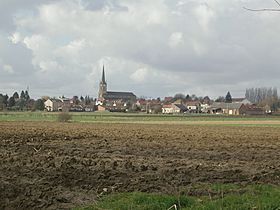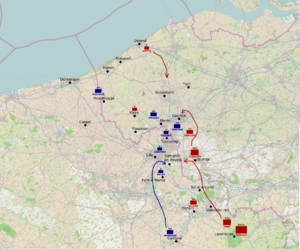Battle of Willems facts for kids
Quick facts for kids Battle of Willems |
|||||||
|---|---|---|---|---|---|---|---|
| Part of the War of the First Coalition | |||||||
 The modern village of Willems |
|||||||
|
|||||||
| Belligerents | |||||||
| Commanders and leaders | |||||||
| Strength | |||||||
| 60,000 | 40,000 | ||||||
| Casualties and losses | |||||||
| 2,400, 13 guns | 325 | ||||||
The Battle of Willems happened on May 10, 1794. It was a fight between the French army and a group of allied forces. These allies included soldiers from Austria, Great Britain, Hanover, and Hesse.
The battle took place near Kortrijk, a city in Belgium. It was part of a bigger conflict called the War of the First Coalition. The French, led by General Charles Pichegru, were trying to continue their successful attacks in the Low Countries. They had already won battles and captured important cities like Menin and Courtrai.
Even though the French lost the Battle of Willems, they won a bigger battle the next day at Courtrai. The Allied commander, the Duke of York, realized his forces were outnumbered. This led the Allies to retreat. So, the French ended up with a strategic victory, keeping control of Menin and Courtrai.
This battle was also important because it was the first time French infantry (foot soldiers) formed defensive squares to successfully stop attacks from Allied cavalry (soldiers on horseback).
Contents
Why the Battle Happened
French Plans for Attack
In the spring of 1794, a French leader named Lazare Carnot came up with a plan. He wanted the French armies to attack the Allied forces from both sides in the Austrian Netherlands.
On the western side, about 100,000 French troops were ordered to attack cities like Ypres and Ghent. On the eastern side, another 100,000 soldiers would push towards Liège. The idea was to surround the Allied armies.
Charles Pichegru became the new commander of the French Army of the North. He had a very large army, with over 227,000 soldiers ready for action.
Allied Defenses
The Allied forces were led by Prince Josias of Saxe-Coburg-Saalfeld. Their right side was commanded by General Clerfayt, who had about 24,000 Austrian, Hanoverian, and Hessian troops. They were defending important towns like Menin and Ypres.
The Duke of York commanded the right-center of the Allied line with 22,000 troops. Prince Coburg, the overall commander, had 43,000 men in the center.
In April 1794, Coburg's main army attacked and surrounded the French fortress of Landrecies. The French surrendered Landrecies on April 30.
The Battle of Mouscron
While the siege of Landrecies was happening, the French were also busy. On April 26, Allied cavalry defeated a French column trying to help Landrecies. They captured the French commander and even Pichegru's battle plans.
However, the French kept pushing. On April 24, French divisions attacked Menin and Courtrai. General Souham's division captured Courtrai.
Even though the Allies knew Pichegru's plans, they couldn't stop the French. On April 29, Souham defeated General Clerfayt in the Battle of Mouscron. The Allies lost many soldiers and guns. The next night, they left Menin. This caused a lot of panic behind the Allied lines.
The Allied Counterattack Plan
After Landrecies fell, Prince Coburg sent the Duke of York's troops to Tournai. By May 3, York's forces joined up with other Allied troops. Together, York and Clerfayt had a large army.
On May 5, the Allied commanders made a plan. Clerfayt would cross the Lys River and attack Courtrai from the north. At the same time, the Duke of York would advance from Tournai to the west. His goal was to cut off Courtrai from the French base at Lille.
York thought the French only had about 24,000 soldiers in the area. He believed his attack would surprise them. However, York's information was wrong. Pichegru actually had 40,000 to 50,000 soldiers between Menin and Courtrai. He also brought in another 20,000 troops from Cambrai. This meant York's planned surprise attack would instead be a head-on fight against a much larger force.
The Battle of Willems
On May 10, 1794, Pichegru launched a major French attack. French divisions, including those led by Souham and Bonnaud, moved forward.
On the right side of the French attack, troops met Austrian soldiers and were stopped. In the center, Bonnaud's division attacked British light troops. The French fought hard and took control of some villages. Bonnaud then set up a large battery of 25 cannons and began firing at the Allied positions.
Cavalry Charges
The Duke of York saw a gap in the French lines. He decided to send 16 squadrons of cavalry (horse soldiers) to attack. This cavalry force was led by William Harcourt.
The ground was mostly flat, but there were fields of rapeseed with furrows. This made it difficult for the horses to charge quickly. When the French infantry saw the cavalry coming, they quickly formed defensive squares. This was a new tactic for them in this war.
The Allied cavalry charged nine times, but they could not break the French squares. The French infantry stood firm. One British regiment, the 6th Dragoon Guards, lost many men and horses trying to charge through a rapeseed field.
To break the stalemate, York sent in British infantry. With their flank (side) now threatened, Bonnaud's French division began to retreat.
Breaking the Squares
The Allied cavalry then charged the French cavalry and made them scatter. But they still couldn't break the French infantry squares. Finally, some British battalion guns (small cannons) arrived. When these guns fired on the squares, the French infantry started to waver.
An officer from the 2nd Dragoons (Scots Greys) bravely rode his horse into a French square, knocking down soldiers. His troopers followed, breaking the square. Seeing this, the French became disorganized. The Allied cavalry then broke two more squares, causing heavy losses for the French foot soldiers.
Soon after, a large group of French cavalry appeared. When charged by the 6th Dragoon Guards, they also scattered.
The French admitted losing about 500 men and 5 cannons. Other sources say the French lost between 1,000 and 2,000 soldiers and 13 cannons. British cavalry losses were around 30 killed and 77 wounded.
By the end of the day, all French units had pulled back to where they started. Even though the Allies won this specific battle, the Duke of York realized how many French troops were in the area. He stopped his advance and asked for more reinforcements.
This battle was important because it was the first time French infantry successfully used squares to defend against cavalry during the war.





